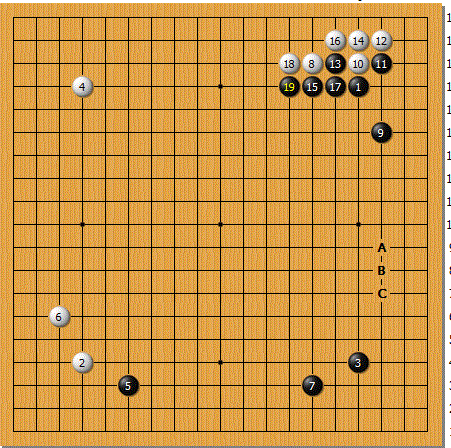I made a couple of posts a few minutes before this one. One mentioned what we can learn from AI and the other mentioned thickness. That brought to mind an article I had looked at recently, which was interesting in its own right but doubly interesting to me because it seemed to show how pro teaching has changed in the AI era.
The following position is from a long series by Suzuki Shinji 7-dan. His main topic is splitting moves (wariuchi), and within that framework miai. He hints at new insights in a jokey way: because of the coronavirus he's had to spend more time at home and so has been drinking less alcohol. In other words, he's got a clearer head. In one sense. Because he's stuck at home with time to think, he now has to make major dilemma choices for himself: hamburger for lunch or noodles. Miai in other words. And although he doesn't mention AI, I think we can very safely assume from the fact that he is a young player and is stuck at home playing on the internet, he has checked his work using a bot.
I detect a change in the way Suzuki and others are explaining their ideas which reflects this background. If I'm also right in thinking that most pros are now having to write their own articles (magazine sales are falling and proper journalists are expensive), that reinforces my impression of a sea-change in go journalism. Even if you don't care to read the Japanese versions, you will be able to see an example of what I mean if you get the new English version of Shibano's "Fuseki Revolution." He obviously used AI in the background but does not obsess about win rates. He still uses ordinary pro talk. He equally obviously write the series himself - very many personal details and quirky choices. I think Suzuki is in the same mould (along with several other younger writers).
Suzuki is performing quite well himself, incidentally. His official score so far this year is 15-10 (low total games because of CV of course). He's 30. (If you like Michael Caine "not many people know that" facts, there are currently four Nihon Ki-in Suzuki 7-dans. There are NOOOOOOOOOOOOOOOO Suzuki 7ps).
As to what I detect as a change in writing style, it's partly that explanations have become a bit longer. In conjunction, far more technical words are being used. An old fashioned article of this type would typically be meagre fare: a few paragraphs pointing us towards a proverb. In the present case, it might focus on the proverb "keep away from thickness." The new style of explanation, however, adds garnishes, and if it mentions proverbs will often remind you they don't always work. In the present case, words that crop up in the longer-than-usual explanation (that is, apart from the obvious ones in the titles - series title: Learning From Splitting Attacks; problem title: Appreciating Thickness - include, miai, moyos, separation (bundan), open-skirt attacks (susogakari), settling (both types: kime and osamari), targets (nerai), good shape (katachi), invasions (or, more strictly, uchikomi), light stones, and sabaki. And all this is written, I'd say, for kyu players, not fancy dans. (AI age go is about multi-tasking (which is maybe why women are doing so well at the moment

)
This rich fare is the result, as I see it, of pros being more aware, because of AI, of the vast web of interconnections that exists on the go board, and they are assuming that their readers are seeing the same webs too when they look at bot play- and so they are giving readers what they think they now expect.
The problem in question is:
Attachment:
 SuzukiMain.GIF [ 66.24 KiB | Viewed 5913 times ]
SuzukiMain.GIF [ 66.24 KiB | Viewed 5913 times ]
You can see at once that this is at least an AI-influenced game. You are asked not so much to choose between A, B and C as to talk about each. That will include a modicum of reading, but I would suggest that the easiest way to approach this might be to try to visualise what might happen in each case and then apply all or some of the technical terms listed above. Ideally, you should be able to make the right selection and sort each item into the right hierarchy, but I think just being able to suss out which terms may or may not apply in each case will be a significant and very useful achievement.
All the problems in the series (5 in each episode) can be handled like this. They are in Go World and are still running after almost two years - a sign of popularity? Although they are in Japanese, I think in this case you can get a lot out of them even if you don't know much Japanese. The diagrams are not usually marked as correct or wrong, but higher kyus and dans should be able to make reasonable judgements. What I would say is essential, though, is to familiarise yourself with the Japanese words for the major terms such as those listed above. If you can spot these in the text you are more than halfway home. (I expect Richard Hunter's books on Japanese will give you the necessary head start.) At least I think you will be able to start appreciating what pros are talking about most in the new AI age. The frequency of certain terms, or frequency of conjunctions of terms, will also be picked up by your subconscious brain at least, leading to a better intuition. As implied above, these remarks apply to other recent serials by younger pros.
Assuming there's some decent response here, I'll give Suzuki's explanations later.



